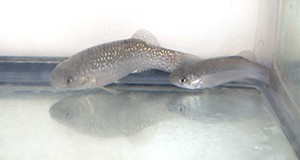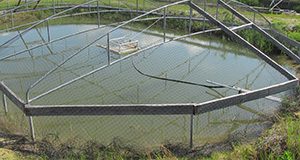Aquaculture is an important and diverse segment of the agricultural economy in Florida. Ornamental, live bait, food finfish, and other segments of this industry culture and trade in non-native species. Escape or release of these non-native cultured organisms is an environmental and legal concern in Florida and therefore a key consideration in aquaculture farm construction and operation. This 7-page fact sheet is the first in a four-part series devoted to educating industry and other stakeholders on the importance of preventing the escape of non-native species from aquaculture facilities as well as strategies for non-native species containment and regulatory compliance. Written by Quenton M. Tuckett, Carlos V. Martinez, Jared L. Ritch, Katelyn M. Lawson, and Jeffrey E. Hill and published by the School of Forest Resources and Conservation Program in Fisheries and Aquatic Sciences, it introduces the series, explains why non-native species containment is important, provides information on regulations, including the Florida Aquaculture Best Management Practices rule, describes the BMP inspection process, and provides advice on achieving compliance with these important regulations.
http://edis.ifas.ufl.edu/fa195
Tag: Tropical Aquaculture Laboratory
Preventing Escape of Non-Native Species from Aquaculture Facilities in Florida, Part 2: Facility Evaluation Strategies
Understanding how non-native species escape or are accidentally released helps producers better design and operate aquaculture facilities to reduce or prevent escape. Active management of critical points where escape is possible will help achieve regulatory compliance. This 6-page fact sheet written by Jeffrey E. Hill, Quenton M. Tuckett, Carlos V. Martinez, Jared L. Ritch, and Katelyn M. Lawson and published by the School of Forest Resources and Conservation Program in Fisheries and Aquatic Sciences is the second in a four-part series devoted to educating industry and other stakeholders on the importance of preventing the escape of non-native species from aquaculture facilities as well as strategies for non-native species containment and regulatory compliance. It describes farm layouts, explains how fish escape, and outlines a process that aquaculturists can complete to identify potential escape points on their farms.
http://edis.ifas.ufl.edu/fa196
Preventing Escape of Non-Native Species from Aquaculture Facilities in Florida, Part 3: Structural Strategies
Non-native species sometimes escape from aquaculture facilities, but producers can prevent these potentially harmful escapes by placing barriers like screens, covers, control structures, and ponds at vulnerable points. Aquaculture producers use these structures to prevent release of non-native species in compliance with Florida Aquaculture Best Management Practices. Further, many of the structures discussed in this 9-page fact sheet are also effective in addressing and maintaining compliance with the discharge requirements of those Best Management Practices. Written by Quenton M. Tuckett, Carlos V. Martinez, Jared L. Ritch, Katelyn M. Lawson, and Jeffrey E. Hill and published by the School of Forest Resources and Conservation, Program in Fisheries and Aquatic Sciences, the fact sheet provides escape prevention strategies and advice for building structures and barriers that can keep potentially harmful non-native species safely contained on aquaculture facilities.
edis.ifas.ufl.edu/fa197
Preventing Escape of Non-Native Species from Aquaculture Facilities in Florida, Part 4: Operational Strategies
Structural strategies to prevent the escape of non-native species from aquaculture facilities have numerous environmental benefits, and research at the UF/IFAS Tropical Aquaculture Laboratory has shown that structural strategies also reduce non-compliance with Florida Department of Agriculture and Consumer Services Best Management Practices. Operational and management strategies, however, are also very important. The strategies discussed in this 6-page fact sheet, the management of water, facilities, and employees, must not be overlooked. Operational strategies are easy, inexpensive, and, when used alongside structural strategies, highly effective, offering an impressive return on a minimal investment in the overall effort to minimize the escape of non-native species.
Written by Quenton M. Tuckett, Carlos V. Martinez, Jared L. Ritch, Katelyn M. Lawson, and Jeffrey E. Hill and published by the School of Forest Resources and Conservation, Program in Fisheries and Aquatic Sciences, this fact sheet is the fourth in a four-part series devoted to educating industry and other stakeholders on the importance of preventing escape of non-native species from aquaculture facilities as well as strategies for non-native species containment and regulatory compliance.
http://edis.ifas.ufl.edu/fa198
Candidate Species for Florida Aquaculture: Gulf Killifish, Fundulus grandis

The Gulf killifish is a promising species for commercial aquaculture in Florida with the potential to help diversify the marine baitfish aquaculture industry in Florida and throughout the southeastern United States. Methods for culturing this species have improved in the past decade; this 6-page fact sheet describes the new methods and some strategies to give producers greater control of reproduction, larval growth, and survival. The publication provides the information producers need to make the most informed decision possible when considering Gulf killifish aquaculture. Written by Shane W. Ramee, Joshua T. Patterson, Cortney L. Ohs, and Matthew A. DiMaggio and published by the Program in Fisheries and Aquatic Sciences, School of Forest Resources and Conservation.
http://edis.ifas.ufl.edu/fa190



